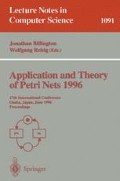Abstract
This paper suggests a way for Petri Net analysis by checking the ordering relations between places and transitions. The method is based on unfolding the original net into an equivalent acyclic description. In an unfolding the ordering relations can be determined directly by the structure of an underlying graph. We improved on the previously known cutoff criterion for truncating the unfolding [10]. No restrictions are imposed on the class of general PNs. The new criterion significantly reduces the size of unfolding obtained by PN. The PN properties for analysis can be various: boundedness, safety, persistency etc. The practical example of the suggested approach is given in application to the asynchronous design. The circuit behavior is specified by an interpreted Petri net, called Signal Transition Graph (STG) which is then analyzed for the implementability by asynchronous hazard-free circuit. The implementability conditions are formulated in such a way that they can be checked by analysis of ordering relations between signal transitions rather than by traversal of states. This allows avoiding the state explosion problem for highly parallel specifications. The experimental results show that for highly parallel STGs checking the implementability by unfolding is one to two orders of magnitude less time-consuming than checking it by symbolic BDD traversal of the corresponding State Graph.
Preview
Unable to display preview. Download preview PDF.
References
T.-A. Chu. Synthesis of Self-timed VLSI Circuits from Graph-theoretic Specifications. PhD thesis, MIT, June 1987.
J. Cortadella, M. Kishinevsky, L. Lavagno, and A. Yakovlev. Synthesizing Petri nets from state-based models. In Proceedings of the International Conference on Computer-Aided Design, November 1995. to appear.
J. Esparza. Model checking using net unfoldings. In M.-C. Gaudel and J.-P. Jouannaud, editors, TAPSOFT'93: Theory and Practice of Software Development. 4th Int. Joint Conference CAAP/FASE, volume 668 of Lecture Notes in Computer Science, pages 613–628. Springer-Verlag, 1993.
T. Esparza, S. Romer, and W. Vogler. An improvement of mcmillan's unfolding algorithm. Technical Report TUM: 19599, Technische Universitat München, August 1995.
M. A. Kishinevsky, A. Y. Kondratyev, A. R. Taubin, and V. I. Varshavsky. Concurrent Hardware. The Theory and Practice of Self-Timed Design. John Wiley and Sons Ltd., 1994.
A. Kondratyev, J. Cortadella, M. Kishinevsky, E. Pastor, O. Roig, and A. Yakovlev. Checking Signal Transition Graph implementability by symbolic BDD traversal. In Proceedings of the European Design and Test Conference (ED&TC), pages 325–332, Paris, France, March 1995.
A. Kondratyev, M. Kishinevsky, A. Taubin, and S. Ten. Analysis of Petri nets by ordering relations in reduced unfoldings. Technical Report TR:95-2-002, The University of Aizu, June 1995.
A. Kondratyev and A. Taubin. Verification of speed-independent circuits by STG unfoldings. In Proceedings of the Symposium on Advanced Reserch in Asynchronous Cirsuits and Systems, pages 64–75, Utah, USA, November 1994.
L. Lavagno and A. Sangiovanni-Vincentelli. Algorithms for synthesis and testing of asynchronous circuits. Kluwer Academic Publishers, 1993.
K. McMillan. A technique of state space search based on unfolding. Formal Methods in System Design, 6(1):45–65, 1995.
T. H.-Y. Meng. Synchronization Design for Digital Systems. Kluwer Academic Publishers, 1991. Contributions by David Mes David Dill.
D. E. Muller. Asynchronous logics and application to information processing. In Proc. Symp. on Application of Switching Theory in Space Technology, pages 289–297. Stanford University Press, 1963.
D. E. Müller and W. C. Bartky. A theory of asynchronous circuits. In Annals of Computing Laboratory of Harvard University, pages 204–243, 1959.
T. Murata. Petri nets: Properties, analysis and applications. Proceedings of IEEE, 77(4):541–580, April 1989.
M. Nielsen, G. Plotkin, and Winskel G. Events structures and domains. Theoretical Computer Science, 13(1):85–108, 1980.
E. Pastor, O. Roig, J. Cortadella, and R. Badia. Petri net analysis using boolean manipulation. In 15th International Conference on Application and Theory of Petri Nets, pages 416–435, Zaragoza, Spain, June 1994.
S. Patil and J. Dennis. The description and realization of digital systems. In Proceedings of the IEEE COMPCON, pages 223–226, N.Y., 1972.
L. Pomello, G. Rozenberg, and C. Simone. A survey of equivalence notions for net based systems. Lecture Notes in Computer Science, 609:410–472, 1993.
A. Semenov and A. Yakovlev. Event-based framework for verifying high-level models of asynchronous circuits. Technical Report TR No.487, Computing Science, University of Newcastle upon Tyne, June 1994.
E. M. Sentovich, K. J. Singh, L. Lavagno, C. Moon, R. Murgai, A. Saldanha, H. Savoj, P. R. Stephan, R. K. Brayton, and A. Sangiovanni-Vincentelli. SIS: A system for sequential circuit synthesis. Technical Report UCB/ERL M92/41, U.C. Berkeley, May 1992.
A. Valmari. State of the art report: Stubborn sets. Petri Nets Newsletter, (46):6–14, 1994.
A. Yakovlev, M. Kishinevsky, A. Kondratyev, and L. Lavagno. OR causality: modelling and hardware implementation. In Proceedings of the 15th International Conference on Application and Theory of Petri Nets, volume 815 of Lecture Notes in Computer Science, pages 568–587, Zaragosa, Spain, June 1994. Springer-Verlag.
Author information
Authors and Affiliations
Editor information
Rights and permissions
Copyright information
© 1996 Springer-Verlag Berlin Heidelberg
About this paper
Cite this paper
Kondratyev, A., Kishinevsky, M., Taubin, A., Ten, S. (1996). A structural approach for the analysis of Petri Nets by reduced unfoldings. In: Billington, J., Reisig, W. (eds) Application and Theory of Petri Nets 1996. ICATPN 1996. Lecture Notes in Computer Science, vol 1091. Springer, Berlin, Heidelberg. https://doi.org/10.1007/3-540-61363-3_19
Download citation
DOI: https://doi.org/10.1007/3-540-61363-3_19
Published:
Publisher Name: Springer, Berlin, Heidelberg
Print ISBN: 978-3-540-61363-3
Online ISBN: 978-3-540-68505-0
eBook Packages: Springer Book Archive

